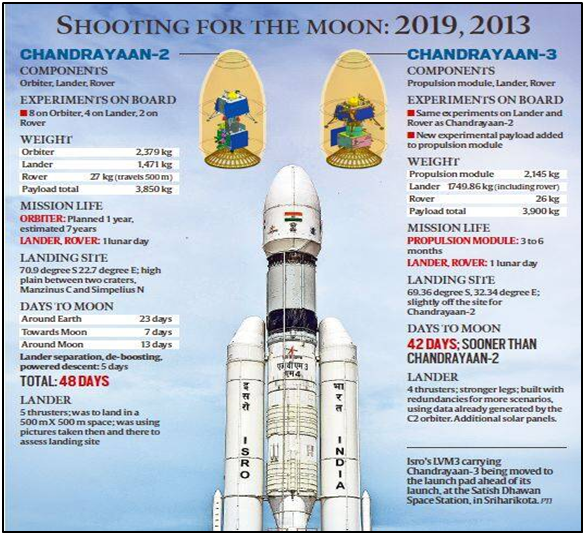Why in News?
- India’s third mission to the moon - Chandrayaan-3 - will take off on 14th July, 2023.
- The mission aims to achieve what its predecessor - Chandrayaan-2 could not - land softly on the lunar surface and explore it with a rover.
- A last-minute glitch led to the failure of the lander's (Vikram) soft landing attempt after a successful orbital insertion.
What’s in Today’s Article?
- The Chandrayaan-3 Mission
- Comparing Chandrayaan 2 and 3 Missions
- Changes in the Mission, Design
- Chandrayaan-3 Payloads
- How will the Mission be Implemented?
- Different Kinds of Moon Missions that have been Launched so far
The Chandrayaan-3 Mission:
- Chandrayaan-3 ("mooncraft") is a planned 3rd lunar exploration mission by the ISRO to demonstrate end-to-end capability in -
- Safe landing (through the lander Vikram - after Vikram Sarabhai, the father of the Indian space programme) and
- Roving (through the rover Pragyan) on the lunar surface.
- Unlike Chandrayaan-2, it will not have an orbiter and its propulsion module will behave like a communications relay satellite.
- Chandrayaan-3 interplanetary mission has three major modules: the Propulsion module, Lander module, and Rover.
- ISRO plans to launch the third moon mission in mid-July aboard the LVM3 (formerly GSLV Mk-III) rocket from Sriharikota.
Comparing Chandrayaan 2 and 3 Missions:

Changes in the Mission, Design:
- Instead of a success-based design in Chandrayaan-2, ISRO scientists are doing a failure-based design in Chandrayaan-3.
- One, the landing area has been expanded. Instead of trying to reach a specific 500mx500m patch for landing as targeted by Chandrayaan-2, the current mission has been given instructions to land safely anywhere in a 4kmx2.4km area.
- Second, the lander has been provided more fuel so it can travel longer distances to the landing site or an alternate landing site, if need be.
- Third, the lander will no longer depend only on the pictures it clicks during the descent to determine a landing site.
- High resolution images from the Chandrayaan-2 orbiter have been fed into the lander and it will click images just to confirm that it has reached the correct location.
- Then, changes have also been made to the physical structure of the lander.
- The central thruster on the lander has been removed, reducing the number from five to four.
- The legs have been made sturdier to ensure it can land even at a higher velocity.
- More solar panels have been added to the body of the lander.
Chandrayaan-3 Payloads:
- The propulsion module: It has Spectro-polarimetry of HAbitable Planet Earth (SHAPE) payload to look for smaller planets that might be habitable in the reflected light.
- Lander payloads: It will have 4 payloads -
- Radio Anatomy of Moon Bound Hypersensitive ionosphere and Atmosphere (RAMBHA) - a passive experiment (from NASA) to help accurately measure the distance between Earth and moon.
- Chandra’s Surface Thermophysical Experiment (ChaSTE) to measure the thermal conductivity and temperature;
- Instrument for Lunar Seismic Activity (ILSA) for measuring the seismicity around the landing site;
- Langmuir Probe (LP) to estimate the plasma density and its variations.
- Rover payloads: Alpha Particle X-ray Spectrometer (APXS) and Laser Induced Breakdown Spectroscope (LIBS) for deriving the elemental composition in the vicinity of the landing site.
How will the Mission be Implemented?
- A propulsion module will carry the lander-rover configuration to a 100-km lunar orbit.
- Once the ‘Vikram’ lander module makes it safely to the moon, it will deploy ‘Pragyan’.
- A successful soft landing will make India the 4th country, after the US, Russia, and China, to achieve the feat.
- The position remains vacant after the missions from Israel and India in 2019 crash-landed and the spacecraft carrying a lander-rover from Japan and a rover from UAE failed in 2022.
- Pragyan will carry out in-situ chemical analysis of the lunar surface during the course of its mobility.
Different Kinds of Moon Missions that have been Launched so far:
- Flybys: These are the missions in which the spacecraft passed near the Moon but did not get into an orbit around it. Examples: Pioneer 3 and 4 by the US and Luna 3 of the then USSR.
- Orbiters: These are spacecraft designed to get into a lunar orbit. Example: India’s Chandrayaan-1 was an Orbiter.
- Impact Mission: One or more instruments on board make an uncontrolled landing (share useful information on their way) on the lunar surface and get destroyed after the impact. Example: Moon Impact Probe (MIP) instrument on Chandrayaan-1.
- Landers (stationary): These missions involve the soft landing of the spacecraft on the Moon. Example: Luna 9 spacecraft of the then USSR - first landing on the moon (1966).
- Rovers (mobile): Rovers are special wheeled payloads on the lander that can detach themselves from the spacecraft and move around on the moon’s surface. Example: Pragyan in the Chandrayaan-2 mission.
- Human missions: These involve the landing of astronauts on the moon’s surface. So far only NASA has been able to land human beings on the moon (between 1969-72). Example: NASA’s Artemis III, currently planned for 2025.









